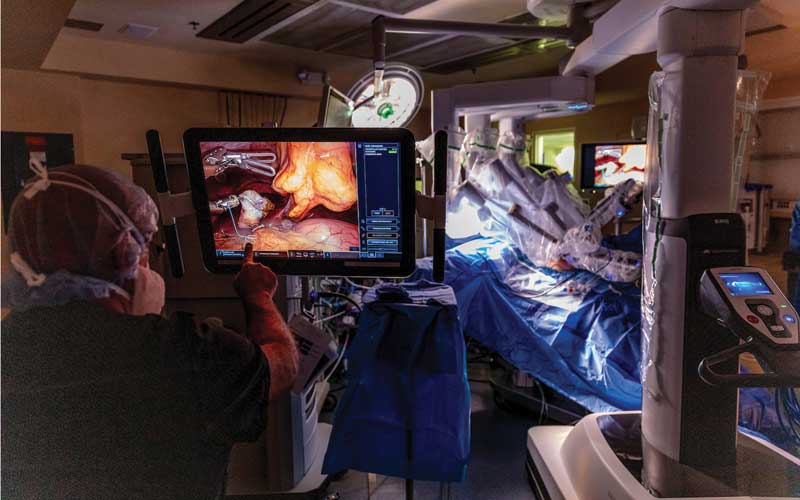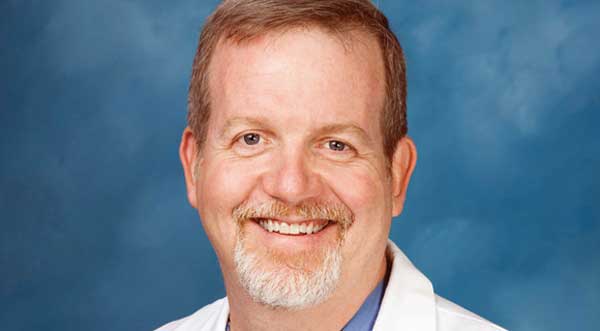Minimally Invasive Robotic Surgeries Resulting in Far Shorter Hospital Stays at Health First
By Space Coast Daily // June 8, 2022
Dr. Nathan Allison performed his 3,000th robotics-assisted surgery at Health First’s Viera Hospital

Nathan Allison, MD, performed his 3,000th robotics-assisted surgery at Health First’s Viera Hospital last month. Days later, Cape Canaveral Hospital onboarded a new da Vinci surgical system.
BREVARD COUNTY, FLORIDA – Minimally invasive. That’s what patients – and physicians – love to hear about their surgeries. Health First procedures via the da Vinci surgical systems are minimally invasive – and so much more, says Viera Hospital’s Dr. Nathan Allison.
“Minimally invasive should now include robotics. It’s an extra layer of sophistication. We’re able to make sure that your surgery stays minimally invasive with superior outcomes.”
More than a decade ago, Dr. Allison was the only fellowship-trained robotics-assisted general surgeon in the state. His NewFit bariatrics practice partner, Dr. Ken Tieu, said the sentiment then was robots were “a gimmick.” The good quality patient outcomes suggest otherwise.

Recently, Dr. Allison marked his 3,000th robotics-assisted surgery. Another fellowship-trained robotics-assisted surgeon, gynecological oncologist Dr. John Bomalaski, who operates at Holmes Regional Medical Center, is expected to surpass 3,000 early this summer, and still another, Dr. Tieu, next year.
Earlier this month, Health First’s Cape Canaveral Hospital performed its first robotics-assisted surgery.
“The view of the surgical field through da Vinci’s 3D console is better than an open procedure, and the instrumentation is incredibly agile,” said Dr. Joseph Bedway, who performed the first procedures.
“The end result is that in these minimally invasive surgeries I’m able to bring all of my knowledge and training, at the very leading edge of technology, and deliver the finest outcomes.”

A Culture of ‘Superior’ Surgery
Patients who undergo robotics-assisted surgeries have a length-of-stay in a Health First hospital of about 1.5 days – the national average for open surgeries is 5 to 15 days.
This incredible patient outcome is the end result of a concerted investment by Health First. Dr. Allison, the health system’s robotics director, has recruited robotics-trained surgeons elsewhere, such as Drs. Matt Campbell and Tamim Antaki at Holmes Regional Medical Center, Drs. Bomalaski and Tieu and many more.
“I would send every one of my family members to a robotics surgeon because I know that you’re going to have a superior surgery,” he said.

Cutting the Conversion Rate
Almost 1 in 4 minimally invasive surgeries in the state converts to “open.” That is, the surgical team is forced to fully open the area in order to complete the procedure, resulting in longer recoveries for patients. At Health First, that rate – called the conversion rate – is less than 1-in-6.
“When your conversion rate is high, that’s not optimal for the patient,” said Dr. Allison. “The last time I converted from a robotics-assisted surgery to an open surgery is probably more than five years ago.”

‘We’re Way Ahead and Still Pushing’
At Viera Hospital, 3 of the 6 operating theaters feature da Vinci surgical systems. Across Health First, there are seven total da Vinci systems. The volume of general surgeries performed this way is remarkably high compared to other hospitals in Central Florida.
“We do a very high volume of very complex surgeries. We’re not just doing lumps and bumps. We’re repairing complex inguinal hernias, complex ventral hernias, big paraesophageal hiatal hernias, bariatric surgeries, sleeves, gastric bypasses,” said Dr. Allison. “I don’t know if there’s a younger surgeon than me who’s hit 3,000 general surgeries in robotics.”
“Nate [Allison] kind of brought this to Brevard County,” said Dr. Tieu, “and it’s nice to know we’re way ahead and still pushing the envelope. But what matters is we’ve shown its worth in patient outcomes, patient successes. That’s all we care about.”
To view more news and follow what’s happening at Health First, go to HF.org/news_and_events.













